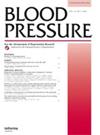较年轻、受教育程度较低的高血压男性家庭血压监测使用率较低——真实数据
IF 2.3
4区 医学
Q2 PERIPHERAL VASCULAR DISEASE
引用次数: 3
摘要
背景:家庭血压监测(HBPM)已成为高血压管理的标准。然而,关于在日常临床实践中使用血压(BP)监测仪的数据很少。目的:本分析的目的是显示:(1)高血压患者配备血压监测仪的频率;(2)他们定期进行HBPM和运行血压日记的频率;(3)在一个大型的现实生活高血压患者队列中,血压监测仪的使用与降压治疗的有效性有什么关联。患者和方法:该调查由570名医生对14200名高血压患者进行,其中12289名(6163名女性;平均年龄(63±12岁)申报使用降压药。每位患者被问及是否在家中定期使用或偶尔使用血压监测仪并记录血压日记。根据两次参加办公室血压测量的平均值来评估血压控制。结果:在配备血压监测仪的患者中(87.2%),73.4%的患者定期进行HBPM, 26.6%的患者偶尔进行HBPM, 66.9%的患者记录血压日记。血压控制占34.5%,其中男性32.9%,女性36.1%;p < 0.001),更频繁地配备血压监测仪(34.9% vs 31.7%, p < 0.001)。女性、受教育程度、职业活动、积极的生活方式、年龄较大、高血压综合治疗、高血压治疗超过5年、糖尿病共存是增加的因素,而饮酒、内源性肥胖和心力衰竭则降低了配备血压监测仪和记录血压日记的可能性。定期HBPM在女性、体力活动者、老年人、糖尿病患者、内脏性肥胖和冠状动脉疾病患者中更为常见。结论:(1)大多数高血压患者已经配备了血压监测仪,(2)四分之三的患者定期进行HBPM,三分之二的患者进行血压日记,(3)仍然需要在年轻,受教育程度低的高血压男性中推广使用血压监测仪。本文章由计算机程序翻译,如有差异,请以英文原文为准。
Lower utilization of home blood pressure monitoring in younger, poorly educated hypertensive males – real-life data
Abstract Background: Home blood pressure monitoring (HBPM) became a standard in the management of hypertension. However, there are few data concerning the utilisation of blood pressure (BP) monitors in daily clinical practice. Aim: The aim of this analysis was to show: (1) how frequently hypertensive patients are equipped with BP monitors, (2) how often they perform regular HBPM and running BP diaries, (3) what are the correlates of utilisation of BP monitors, in a large real-life cohort of hypertensives examined for the efficacy of antihypertensive therapy. Patients and methods: The survey was conducted by 570 physicians among 14,200 hypertensive patients, of whom 12,289 (6163 women; mean age 63 ± 12 years) declared use of antihypertensive medicines. Each patient was asked whether at home is having and using regularly or occasionally BP monitor and running BP diary. BP control was assessed based on the mean of two attended office BP measurements. Results: Among patient equipped with BP monitors (87.2%), 73.4% were conducting HBPM regularly, while 26.6% occasionally, and 66.9% were running BP diaries. Controlled BP was achieved by 34.5% (32.9% men and 36.1% women; p < .001), more frequently by equipped with BP monitors (34.9 vs 31.7%, p < .001). Female sex, education, professional activity, active lifestyle, older age, hypertensive polytherapy, longer than 5-year therapy for hypertension, and coexistence of diabetes were factors increasing, while alcohol consumption, visceral obesity and heart failure decreasing the probability of being equipped with BP monitor and running BP diary. Regular HBPM were more frequently among women, physically active, older, diabetics, viscerally obese and patients with coronary artery disease. Conclusions: (1) The majority of hypertensive Poles are already equipped with BP monitors, (2) three-fourth patients perform regular HBPM and two-third run BP diaries, (3) there is still a need to promote utilisation of BP monitors among younger, poorly educated hypertensive males.
求助全文
通过发布文献求助,成功后即可免费获取论文全文。
去求助
来源期刊

Blood Pressure
医学-外周血管病
CiteScore
3.00
自引率
5.60%
发文量
41
审稿时长
6-12 weeks
期刊介绍:
For outstanding coverage of the latest advances in hypertension research, turn to Blood Pressure, a primary source for authoritative and timely information on all aspects of hypertension research and management.
Features include:
• Physiology and pathophysiology of blood pressure regulation
• Primary and secondary hypertension
• Cerebrovascular and cardiovascular complications of hypertension
• Detection, treatment and follow-up of hypertension
• Non pharmacological and pharmacological management
• Large outcome trials in hypertension.
 求助内容:
求助内容: 应助结果提醒方式:
应助结果提醒方式:


